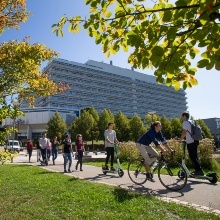The University of Stuttgart wants to be a pioneer in low-emission mobility in the future, both in terms of research and putting it into practice. This is why it is taking part in the “Mobility concepts for an emissions-free campus” ideas competition. In order to achieve an attractive and welcoming campus, it should be mostly car-free. In future, people could arrive at the Campus Vaihingen, when using their car, via a central car park on the edge of the campus. From there and the S-Bahn station, the campus will be accessed by new types of low-emission mobility. The parking lots freed up as a consequence of this provide space for new developments and buildings (if financed by the State). The project is lead by Prof. Markus Friedrich, Holder of the Chair of Transportation Planning and Traffic Engineering at the Institute for Road and Transport Engineering, of our faculty.
Framework conditions
The Campus Vaihingen is already very well connected by public transport. The Campus Vaihingen site also brings in people from beyond the immediate area, meaning a lot of people using their car. The combination of the parking facility management system, the car-free campus and the new mobility options will lead to a fall in demand for car parking spaces of about one third.
Mobility concept
- Parking facility: above the B14 highway with direct access, solar panels on the roof, smart grids and test field for new forms of inductive charging
- Bike rental system: RegioRad Stuttgart in cooperation with the City of Stuttgart finally gets nine rental stations on campus (72 bikes planned, 1st station planned for the 1st quarter of 2020)
- innovative E-Scooter: 600 electric scooters, self-drving when unmanned, should always be optimally distributed algorithm-controlled (thus replacing ten normal electric scooters each)
- Shuttle buses: 10 shuttle buses connect the central parking facility, the S-Bahn station and important points on the campus and at the same time are test vehicles for automatic public road transport, e-mobility and inductive charging on the road.
| Contact | Prof. Dr.-Ing. Markus Friedrich, Institute for Road and Transport Engineering, Chair for Transport Planning and Traffic Engineering, Pfaffenwaldring 7, D-70569 Stuttgart, +49 711 685-82482, markus.friedrich@isv.uni-stuttgart.de |
|---|


